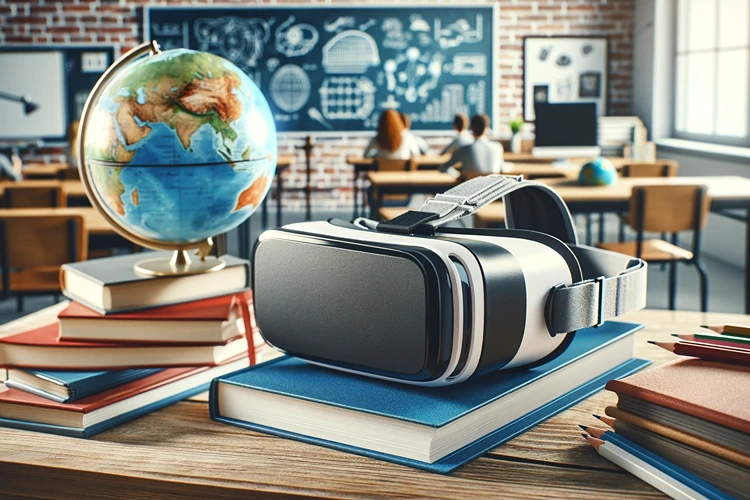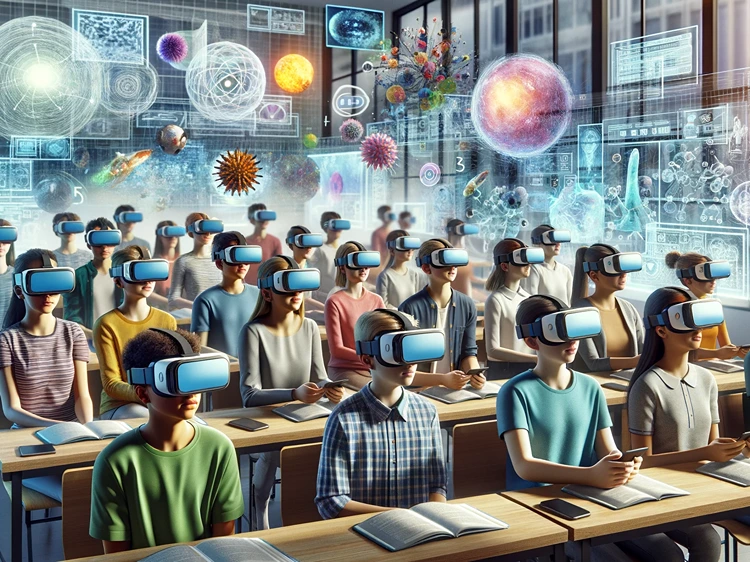Virtual reality is reshaping educational landscapes, offering immersive, interactive experiences that traditional learning methods cannot match. This revolution in how we learn highlights the significant role of VR in education, from enhancing student engagement and retention to providing access to experiences far beyond the classroom walls. Our exploration into virtual reality’s impact on education delves into its benefits, challenges, and the promising future it holds for students and educators alike.
Why Is VR a Game-Changer in Education?
VR’s immersive nature allows students to experience learning in a way that traditional methods cannot match. Historical timelines transform into interactive journeys. Biological concepts become up-close personal explorations. The cosmos unfolds in a classroom. Such experiences cater to various learning styles, significantly enhancing comprehension and retention. Visual and kinesthetic learners, in particular, benefit from VR’s hands-on approach, making abstract concepts tangible and easier to understand.
Helpful Hint:
Integrating VR into educational settings goes beyond merely adopting new technology; it involves reimagining the learning experience to make it more immersive, engaging, and effective across diverse student populations.
Exploring the Benefits of VR in Learning
- Enhanced Engagement: VR’s interactive nature captures students’ attention far more effectively than traditional learning methods, making education both engaging and enjoyable.
- Improved Retention: The immersive experiences provided by VR help solidify learning, with studies showing significant improvements in the retention of information when VR is used.
- Accessibility: VR enables students to explore places and concepts that are otherwise inaccessible, bridging gaps in educational resources and opportunities.
By offering solutions to longstanding educational challenges, VR paves the way for a more inclusive and effective learning environment.
Challenges and Considerations for Implementing VR in Education

Despite its many benefits, integrating virtual reality into educational curricula presents its own set of hurdles. The initial high costs of VR hardware and the continuous need for technical support stand as significant barriers to widespread adoption. Furthermore, educators face the challenge of navigating the quality of VR content to ensure it aligns with educational standards and is appropriate for classroom use. Addressing the potential for motion sickness and guaranteeing that VR experiences are accessible to all students, including those with disabilities, are crucial for fully realizing Virtual Reality’s Impact on Education. These considerations are vital for educators and institutions aiming to harness VR’s potential to transform learning environments.
Stats:
Utilizing VR in educational settings has led to a 30% increase in retention rates among students, compared to conventional learning methods, underscoring the effectiveness of immersive learning.
Practical Applications of VR in Education
- Historical Reenactments: VR allows students to experience historical events first-hand, enhancing understanding and empathy through personal experience.
- Scientific Exploration: The detailed and immersive nature of VR aids in the comprehension of complex scientific concepts, from molecular biology to astronomical phenomena.
- Language Learning: By simulating real-life interactions in various languages, VR provides a powerful tool for language acquisition and practice.
How Educators Can Integrate VR into Their Curriculum
- Start Small: Educators are encouraged to begin with basic VR applications to gradually introduce the technology to students and staff.
- Focus on Learning Objectives: Selecting VR content that aligns with curriculum goals ensures that technology enhances rather than distracts from the learning experience.
- Ensure Accessibility: Providing alternatives for students who might not comfortably use VR due to motion sickness or other concerns is essential for inclusive education.
Helpful Hint:
Selecting VR content with interactive features can significantly enhance student engagement and learning outcomes. Interactive VR experiences encourage active rather than passive learning.
The Future of VR in Education: What’s Next?
The trajectory of VR in education points towards more widespread adoption and integration. As technology advances, costs are expected to decrease, making VR tools more accessible to educational institutions across the globe. The development of new VR content and educational platforms, tailored specifically for immersive learning, will further enhance the educational potential of VR. Augmented reality (AR) and artificial intelligence (AI) are set to play complementary roles, offering a holistic and personalized learning experience. This suggests a future where VR and AR tools become as integral to education as traditional textbooks, reshaping learning for generations to come. In essence, Virtual Reality’s Impact on Education is poised to redefine the educational experience, promising an era of enhanced learning through technology.
Stats:
Anticipated growth in the use of VR for educational purposes is estimated at 30% over the next five years, indicating its rising importance in innovative teaching strategies.
Helpful Hint:
For educators and institutions looking to incorporate VR into their educational toolkit, keeping abreast of the latest developments in VR technology and pedagogical applications is crucial for maximizing its benefits.
Pros and Cons of Virtual Reality in Education
Pros
- Immersive Learning: Provides an immersive experience that enhances understanding and retention.
- Engagement: Increases student engagement by making learning interactive and enjoyable.
- Accessibility: Offers access to experiences and locations that are otherwise inaccessible, broadening educational possibilities.
- Customizable Content: Allows for the creation of tailored educational experiences to meet diverse learning needs.
- Practical Skills: Facilitates the development of practical skills through simulated environments.
Cons
- Cost: High initial setup and ongoing maintenance costs can be a barrier to widespread adoption.
- Technical Challenges: Requires technical expertise for setup, maintenance, and troubleshooting.
- Health Concerns: May cause motion sickness or eye strain in some users.
- Accessibility Issues: Not all students have equal access to VR technology, potentially widening the digital divide.
- Content Quality: Varies significantly, with a need for careful selection to ensure educational value.
FAQs
Wrapping Up
Virtual reality represents a significant shift in the educational landscape, offering immersive, engaging experiences that traditional methods cannot match. From historical explorations to scientific discoveries and beyond, VR has the potential to transform how we learn, making education more interactive, accessible, and enjoyable. Despite challenges like cost and technical requirements, the advantages of VR in education — including enhanced engagement and improved retention — make it a valuable tool for the future of learning.
As technology continues to evolve, the potential for VR in education expands, promising even greater opportunities for immersive learning experiences. For educators, students, and institutions, staying informed about VR developments and exploring its integration into curricula will be key to unlocking its full potential. The impact of virtual reality on education is just beginning, with its true value yet to be fully realized in the years to come, underscoring Virtual Reality’s Impact on Education as a transformative force in shaping future learning landscapes.
Additional Resources
- Oculus VR: Explore the latest in VR technology for education and gaming. Oculus provides a range of VR headsets and experiences perfect for educational purposes.
- HTC Vive: Discover how HTC Vive’s VR solutions are being used in classrooms to provide immersive learning experiences across various subjects.
- Google for Education: VR and AR: Google offers tools and programs to help educators integrate VR and AR into their curriculum, making learning more interactive and engaging.
